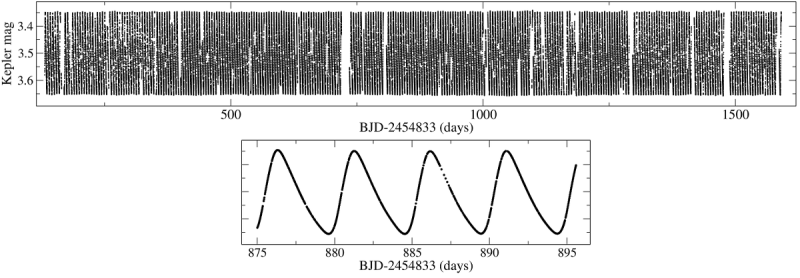Kepler watched a Cepheid star boil

After four years of continuous monitoring, astronomers detected clear signs of convective cells in a giant pulsating star for the first time using the Kepler space telescope.
Cepheid variable stars are luminous pulsating stars that experience strong periodic variations both in size and brightness, typically on timescales ranging from days to weeks. Since they are very bright, they can easily be spotted in galaxies beyond the Milky Way. The light variations of Cepheids can be used to calculate the distances to those galaxies and to calibrate our distance measurements throughout the universe.
The original field-of-view of the Kepler space telescope contained a single Cepheid star named V1154 Cyg that was the target of intense scrutiny. After the original mission of Kepler ended, a team of Hungarian astronomers from the Gothard and Konkoly Observatories analysed the entire data set, which spanned 1460 days and contained more than 52 thousand measurements. The data led to multiple discoveries. The team found that the star experiences regular, long-term variations: The strength and length of the 4.9-day pulsation changes very slightly over a period of 159 days. The astronomers are still trying to figure out the physical origins of this phenomenon. "One of the long-standing mysteries of stellar pulsation are these modulations seen in some pulsating stars," says Aliz Derekas, a postdoctoral researcher at Gothard Astrophysical Obseratory, the lead author the study. "We don't know yet what causes it, but our spectroscopic measurements already ruled out the presence of a companion star around the Cepheid as a possible cause behind the 159-day cycle."
The most important discovery is the detection of the so-called granulation noise in the data. Granulation is the constant boiling of the stellar surface created by the convective motions of the stellar material as it transports energy outward, just like boiling water circulates in a heated pot. We can see these motions in action only on the sun, but we know that basically all cool-temperature stars exhibit convective granulation. That is because the constant "buzzing" of the convective cells, as they appear and disappear on the surface, adds a small, low-frequency noise to the light variations. Indeed, the Kepler space telescope has measured these granulation noise signals in thousands of sun-like stars and red giant stars. But none of those are as large and heavy as V1154 Cyg, and neither of them pulsates. Apart from a very weak, tentative signal in Polaris, no one has ever observed granulation in a Cepheid before.
The exquisite measurements of Kepler revealed that granules, the small individual convective cells, persist for three to four days on average until they run out of material and other granules replace them. This is much longer than the 10- to 20-minute lifetime of the granules seen on the sun, but agrees with what astronomers would expect from a star that is 45 times larger in diameter.
The researchers also expected to find solar-like oscillations, but were unable to make such detections. These are low-level, irregular brightness variations caused by sound waves traveling in the star, like in our sun. "Apparently, the presence of strong pulsation, when the layers of the star move back and forth in unison, prevent these incoherent oscillations from occurring in a Cepheid," László Molnár (Konkoly Observatory), co-author of the paper, explained.
The astronomers plan to compare their results to other Cepheids, but observations like this are difficult to come by. They require long, frequent, and uninterrupted measurements of brightness variations, something that few space telescopes can provide. As Emese Plachy, another co-author from Konkoly Observatory, said, "The next space mission, TESS, will observe a handful of Cepheids for almost one year, and we expect that at least one of them will be a good target for a similar study. But beyond that, we are left waiting and preparing for the European PLATO mission in the mid-20s."
More information: Derekas A., et al.: The Kepler Cepheid V1154 Cyg revisited: light curve modulation and detection of granulation, Monthly Notices of the Royal Astronomical Society (2016). dx.doi.org/10.1093/mnras/stw2399, arxiv.org/abs/1609.05398
Journal information: Monthly Notices of the Royal Astronomical Society
Provided by Konkoly Observatory





















